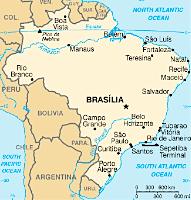RIO DE JANEIRO, Brazil -- Brazil defies definition. Its contrasts and contradictions are everywhere -- from the Europeans of the south to the African heritage of Bahia, the megalopolis of Sao Paulo to the untouched remoteness of the Amazon, the joyous samba amid the chronic gun violence of the shanty settlements. It has world-class companies like energy giant Petrobras, but in many ways is a highly uncompetitive economy. But the most overwhelming contrast is between the fabulously wealthy and the desperately poor. By every international measurement, Brazil is one of the most unequal societies on earth, a condition that has held back its development and fueled one of the highest homicide rates in the world. The largest shanty town or favela in Rio de Janeiro is Rocinha. It clambers up steep hillsides within a few hundred yards of wealthy and highly secure apartment blocks. Rocinha is a maze of alleyways with some 200,000 residents -- most of them black and most immigrants from the poor northeast. Brazilian funk and samba blare from tiny shops and bars. Like scores of favelas around Rio and Brazil's other major cities, Rocinha has been largely neglected by city, state and federal government. Even though many residents have never lived anywhere else, they are regarded as squatters. Garbage is cleared by community groups, electricity is often "stolen" via a tangle of dangerous wires. The only time the police are seen is in a helicopter above or when they stage a well-armed drugs raid. Rocinha, like many of the favelas that are home to about one million of Rio's residents, is self-governing, and the community works with the consent of the trafficking gangs, the favelas' most lucrative and organized businesses. The dominant gang in Rocinha is Amigos dos Amigos; there are constant turf wars between the gangs, often with machine guns and rocket-propelled grenades. It is not unusual to see teenagers on scooters brandishing heavy weapons. The movie "City of God" did not have to exaggerate the violence and drug-fueled crime of Rio's favelas. The wealthy of Rio inhabit a nearby but entirely separate universe, and only come into contact with the "other" Brazil when they are robbed or when the maid reports for work. They live in enclaves surrounded by high walls, or in secure apartment blocks. In Sao Paulo, company executives use helicopters to get to work, both because of the city's chronic traffic congestion and because they're less likely to get abducted or robbed several hundred feet in the air. Despite Brazil's rapid modernization -- driven by its wealth in raw materials and agriculture -- the scale of inequality changed little in the last 20 years of the 20th century. At the dawn of the new millennium, 20 percent of Brazilians held two-thirds of its wealth, while the poorest twenty per cent possessed just two per cent.
In 2nd Term, Brazil’s Lula May Continue Drift Toward Center on Economy

